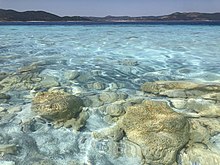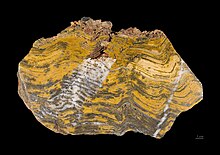



Microbialite is a benthic sedimentary deposit made of carbonate mud (particle diameter less than 5 μm) that is formed with the mediation of microbes. The constituent carbonate mud is a type of automicrite (or authigenic carbonate mud); therefore, it precipitates in situ instead of being transported and deposited. Being formed in situ, a microbialite can be seen as a type of boundstone where reef builders are microbes, and precipitation of carbonate is biotically induced instead of forming tests, shells or skeletons.
Microbialites can also be defined as microbial mats with lithification capacity.[2] Bacteria can precipitate carbonate both in shallow and in deep water (except for Cyanobacteria) and so microbialites can form regardless of the sunlight.[3]
Microbialites are the foundation of many lacustrine ecosystems, such as the biosystem of the Great Salt Lake with its millions of migratory birds[4] or, serving in the Alchichica Lake as nurseries for axolotl (Ambystoma taylori) and a variety of fish.
Microbialites were very important to the formation of Precambrian and Phanerozoic limestones in many different environments, marine and not. The best age[clarify] for stromatolites was from 2800 Ma to 1000 Ma when stromatolites were the main constituents of carbonate platforms[3]
- ^ Schmid, D.U. (1996). "Mikrobolithe und Mikroinkrustierer aus dem Oberjura". Profil. 9: 101–251.
- ^ Dupraz, Christophe; Visscher, Pieter T. (September 2005). "Microbial lithification in marine stromatolites and hypersaline mats". Trends in Microbiology. 13 (9): 429–438. doi:10.1016/j.tim.2005.07.008. PMID 16087339.
- ^ a b Erik., Flügel (2010). Microfacies of carbonate rocks : analysis, interpretation and application. Munnecke, Axel. (2nd ed.). Heidelberg: Springer. ISBN 9783642037962. OCLC 663093942.
- ^ "Drought Negatively Impacting Great Salt Lake Microbialites and Ecosystem". Utah Geological Survey. Department of Natural Resources. 15 July 2021. Retrieved 18 July 2021.